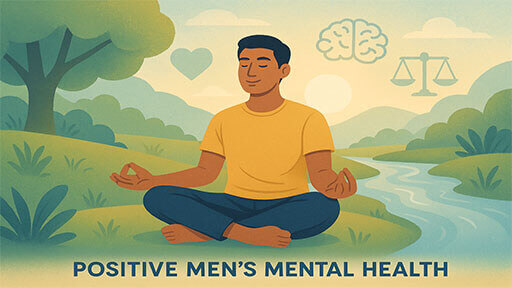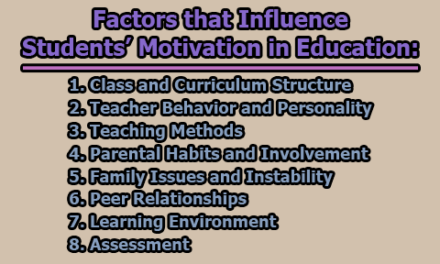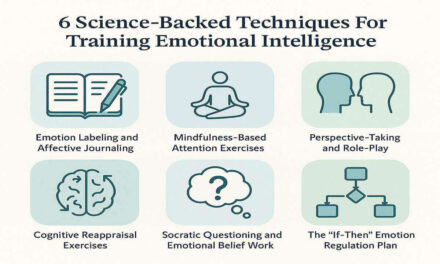Positive Men’s Mental Health:
Men’s mental health is a subject often overlooked, hidden beneath layers of silence, stigma, and outdated stereotypes. Despite growing awareness, many men continue to struggle privately, reluctant to share their pain or seek help. Statistics highlight the urgency: men are twice as likely to die by suicide as women, and nearly half avoid discussing their mental health with anyone at all. Behind these numbers are real stories — of exhaustion, silent battles, and lives cut short. Yet, there is also hope. By challenging harmful myths, embracing vulnerability, and fostering open conversations, men can find healthier ways to cope and thrive. This article explores the unique challenges face in maintaining positive men’s mental health and offers practical steps to support wellbeing in everyday life.
What Is Positive Mental Health?
Men’s Mental Health Month is an opportunity not only to raise awareness about the struggles men face but also to reframe the conversation toward what it truly means to experience positive mental health. Too often, discussions about mental health are framed in terms of illness, problems, or deficits. While acknowledging challenges is important, positive mental health emphasizes that wellbeing goes beyond the absence of mental illness and involves cultivating strengths, resilience, and meaning in life.
First, it is important to recognize that mental health is not simply categorical — something you either have or don’t have. Instead, it is bidimensional, existing on a spectrum that includes both difficulties (such as stress, anxiety, or depression) and positive psychological resources (such as resilience, wellbeing, and a sense of purpose). This perspective acknowledges that a person may experience emotional struggles while still drawing on inner strengths and living a meaningful life.
Another key misconception is that positive mental health requires constant happiness. In reality, being mentally healthy does not mean avoiding difficult emotions altogether. Feelings like sadness, anger, fear, frustration, or grief are part of the normal human experience. Experiencing these emotions does not mean that something is “wrong” with you. Rather, positive mental health involves being able to navigate these emotions in a way that allows you to continue functioning, connecting with others, and finding meaning despite the challenges.
The World Health Organization (2004, p. 1) defines mental health not merely as the absence of illness, but as “a state of wellbeing in which the individual realizes his or her own abilities, can cope with the normal stresses of life, can work productively and fruitfully, and is able to make a contribution to his or her community.” This definition emphasizes balance, resilience, and the ability to participate fully in life — elements that reflect both personal wellbeing and social connectedness.
Building on this, psychologist Martin Seligman (2011) highlights that positive mental health is rooted in the presence of wellbeing. It includes cultivating positive emotions, nurturing healthy relationships, finding meaning and purpose, achieving a sense of accomplishment, and developing resilience in the face of stress or adversity. In other words, mental health is about more than avoiding pain — it’s about creating conditions that allow individuals to grow, thrive, and lead fulfilling lives.
By shifting the narrative toward this broader and more hopeful view of mental health, especially during Men’s Mental Health Month, we can encourage men not only to seek help when they are struggling but also to embrace everyday practices that build wellbeing. This shift empowers men to see mental health as an ongoing, active process — one that includes challenges, but also possibilities for growth, strength, and positive change.
Why Men’s Mental Health Matters:
The men in our lives — fathers, uncles, brothers, partners, friends, and colleagues — often carry struggles that remain unseen. While outwardly they may appear strong, self-reliant, or “fine,” the reality is that many men are silently battling mental health challenges that go unrecognized or unspoken.
Statistics make this hidden struggle painfully clear. Globally, men are more than twice as likely to die by suicide compared to women (World Health Organization, 2021). This staggering figure alone reflects the depth of the crisis. But it does not stand in isolation. Men also face disproportionately higher rates of substance misuse, incarceration, and involvement in violence (Rice et al., 2018). These issues are not only markers of poor mental health but also reinforce cycles of suffering that affect families, communities, and society as a whole.
Interestingly, when it comes to commonly reported mental health conditions like anxiety and depression, men are often shown to have lower rates than women. At first glance, this might suggest that men are less affected. However, researchers and clinicians warn that these numbers may not tell the full story. The discrepancy is often attributed to stigma and cultural norms that discourage men from acknowledging or reporting their struggles.
From a young age, many boys and men are socialized to embrace ideals of toughness, self-reliance, and stoicism. Phrases like “man up” or “tough it out” send the message that vulnerability is weakness, and that asking for help is somehow unmanly. Over time, these beliefs can prevent men from developing healthy ways of coping with emotions or seeking support when life feels overwhelming. Instead, emotions are often suppressed, leading to shame, disconnection, and withdrawal.
This cultural conditioning creates barriers not only to accessing mental health services but also to building emotional literacy — the ability to identify, understand, and express emotions. Without these tools, many men may turn to unhealthy coping strategies, isolate themselves, or endure suffering in silence.
It is for these reasons that men’s mental health is frequently described as a “silent crisis.” Unlike a crisis that erupts suddenly and visibly, this one often unfolds quietly, behind closed doors, until its consequences become devastating. Without intervention — through awareness, accessible support systems, and a cultural shift in how we view masculinity — the situation is likely to worsen.
Addressing men’s mental health matters not only because it saves lives, but because it enriches relationships, families, and communities. When men are supported in expressing vulnerability, seeking help, and building resilience, the ripple effects create healthier societies for everyone.
How Do Men Experience Mental Health Struggles?
Mental health challenges are not rare among men — in fact, they are common and widespread (Priory, 2023). However, the way men experience and express these struggles can differ significantly from women. Traditional masculine norms, the stigma surrounding vulnerability, and lifelong social conditioning often shape how men understand (or fail to understand) their own emotions. As a result, their mental health struggles are frequently overlooked, minimized, or even misdiagnosed.
One of the reasons for this invisibility is that men often do not describe their mental health in ways that align with traditional diagnostic categories. Instead of saying they feel “sad” or “depressed,” many men frame their experiences in terms of stress, anger, exhaustion, or emotional numbness. These expressions may actually reflect underlying depression, but they are not always recognized as such by health professionals or even by the men themselves (Bilsker et al., 2018).
Externalizing Symptoms: Research suggests that men are generally less likely to display internalizing symptoms, such as persistent sadness, withdrawal, or crying, and more likely to express externalizing symptoms. These may include irritability, heightened anger, risk-taking behaviors, or reliance on alcohol and other substances as coping mechanisms (Bilsker et al., 2018). Such behaviors can mask underlying psychological distress, making it harder for friends, family, and even clinicians to recognize that these are signs of mental health struggles rather than “just stress” or “bad habits.”
In everyday conversations, a man might say, “I’m exhausted,” or “I feel numb,” without realizing that these statements can be symptomatic of depression. Unfortunately, because these expressions do not fit neatly into the conventional picture of mental illness, they can go unnoticed, leaving the deeper issues unresolved.
Somatic Symptoms: Another common way men experience psychological distress is through somatic symptoms — physical manifestations of mental health problems. Anxiety, for example, may present as chest pains, headaches, stomach issues, or panic attacks (McKenzie et al., 2022). These bodily expressions of distress often feel more tangible and acceptable to men, leading them to seek medical help for physical discomfort rather than emotional pain.
Indeed, men are more likely to approach a doctor about physical symptoms than to openly discuss feelings of sadness, hopelessness, or anxiety (National Institute of Mental Health, 2024). While this can sometimes provide a pathway to eventual recognition and treatment, it also means that many mental health struggles are missed or delayed in diagnosis. The focus remains on alleviating the physical discomfort, while the underlying psychological causes remain unaddressed.
Taken together, these patterns highlight how men’s mental health struggles are often hidden behind anger, stress, physical pain, or risky behaviors. Recognizing these unique expressions is essential if we are to bridge the gap in diagnosis and treatment. By broadening our understanding of how men experience distress, we can create more effective support systems — ones that validate men’s experiences and encourage them to seek help without shame.
What Affects Men’s Mental Health?
Men’s mental health is influenced by a wide range of factors that overlap with those affecting everyone — such as genetics, environment, trauma, and lifestyle choices (World Health Organization, 2022). However, men also face unique pressures that shape how they experience, understand, and cope with their internal worlds. These pressures come from cultural expectations, changing definitions of masculinity, and the social environments in which men live and work. Together, they create a complex web of influences that can both hinder and support men’s wellbeing.
- Traditional Gender Norms: Across many cultures, men are raised with a clear set of expectations: be strong, competitive, self-reliant, and emotionally restrained. The ideal man is often portrayed as someone in control, dominant, and unaffected by vulnerability. While these traits may seem admirable on the surface, they can also create deep internal conflicts. Emotions such as sadness, fear, or anxiety — which are part of the human condition — may be seen as signs of weakness, triggering shame and self-hatred rather than compassion or understanding.
This mindset can have serious consequences. Some men internalize the belief that expressing their feelings will damage how others perceive them, making them appear weak or incapable. As a result, even when they feel exhausted, angry, overwhelmed, or devastated, they may remain silent. Without access to emotional tools or safe spaces to express themselves, many men withdraw, isolate, or turn to unhealthy coping strategies.
- The Changing Face of Masculinity: Fortunately, ideas about masculinity are evolving. Increasingly, men are rejecting rigid and outdated ideals that limit emotional expression. Instead, they are embracing a more flexible and inclusive version of masculinity that values emotional literacy, vulnerability, nurturing roles, and diversity. This shift allows men to seek help earlier, open up about their struggles, and define success beyond material achievements.
Still, this transformation is uneven. While some men feel empowered to challenge stereotypes and connect more authentically, others remain caught between old expectations and new possibilities. The cultural shift is underway, but it is not yet universal, leaving many men navigating a confusing in-between space.
- Meaning and Purpose: A sense of meaning and purpose is fundamental to mental wellbeing. The American Psychiatric Association (2023) emphasizes that fulfillment in life — having goals, values, and a sense of contribution — is closely tied to positive mental health. For many men, meaning has traditionally been connected to roles as providers and protectors.
When crises such as job loss, divorce, or retirement occur, they can feel like profound failures, shaking the foundation of identity and self-worth. Sharp et al. (2022) note that such life transitions can create intense psychological distress, particularly when they are experienced as falling short of societal expectations of masculinity.
- Mixed Messages About Masculinity: Modern men are also bombarded with contradictory cultural messages about what it means to be a man. In some corners of social media and hypermasculine spaces, the “real man” is still depicted as unemotional, financially successful, physically fit, and sexually dominant. In other spaces, men are portrayed as toxic, privileged, and dangerous because of their testosterone. At the same time, mental health advocates urge men to be more open, vulnerable, and emotionally expressive.
Navigating these conflicting messages can leave men feeling uncertain about their identity, purpose, and place in society. Instead of clarity, these mixed signals can amplify confusion and insecurity, undermining their sense of stability and wellbeing.
- Social Connection and Loneliness: Loneliness is increasingly recognized as a serious public health issue, described by the Office of the Surgeon General (2023) as an epidemic. Men, in particular, are at high risk. Many report having fewer close friendships and limited social networks, with fewer people they feel comfortable confiding in (Junttila et al., 2015).
This isolation has devastating effects. Loneliness is strongly linked to depression, cardiovascular disease, and premature death, including suicide (Park et al., 2021). Masculine norms that discourage openness and vulnerability make it harder for men to build meaningful connections. Furthermore, negative past experiences of being dismissed or misunderstood after opening up can discourage them from trying again (Lear & Dorstyn, 2024; McKenzie et al., 2018).
- Stress and Burnout: Another major influence on men’s mental health is the pressure to succeed. Many men feel an intense responsibility to provide, achieve, and remain emotionally unaffected, even under stress. Without healthy coping mechanisms or support, these pressures can lead to chronic stress and burnout, draining both physical and emotional resources (Boettcher et al., 2019).
- Diversity of Male Experience: Finally, men’s mental health cannot be understood through gender alone. Intersectional factors — including race, sexuality, socioeconomic status, and disability — deeply shape how men experience and express mental health struggles. These factors can intensify stigma, limit access to care, and influence coping strategies. For example, men from marginalized communities may face multiple layers of discrimination and cultural expectations, which further complicate their ability to seek and receive support (Funer, 2023).
In brief, men’s mental health is shaped by a dynamic mix of cultural expectations, evolving ideas of masculinity, social connections, life transitions, and individual identities. Addressing these issues requires both systemic changes — such as reducing stigma and increasing access to support — and personal changes, including the cultivation of emotional awareness and healthier coping mechanisms. Only by acknowledging this complexity can society begin to respond effectively to the silent crisis facing men today.
Strengths-Based Practices for Men’s Mental Health Month:
As we observe Men’s Mental Health Month, it is important not only to recognize the struggles men face but also to highlight strategies that foster resilience, growth, and healing. While much of the conversation around men’s mental health focuses on the challenges, stigma, and risks, there is also great value in focusing on strengths-based practices. These practices aim to identify and build upon the resources, skills, and inner capacities men already have, rather than focusing solely on problems or deficits. Research shows that strengths-based approaches can enhance positive mental health and promote resilience by helping individuals recognize and activate their unique resources (Flückiger et al., 2023).
- Strengths Assessment: A practical starting point for building mental health is self-reflection. Ask yourself: What are my strengths? What am I good at? What skills have helped me succeed in the past? Strengths do not always have to be grand achievements; they can be simple qualities like patience, determination, creativity, or the ability to listen well.
It can also be valuable to ask trusted friends, colleagues, or family members what they see as your strengths. Sometimes others recognize qualities in us that we overlook in ourselves. Looking for recurring themes in their responses can provide insight into abilities or traits you might take for granted. Importantly, strengths are not only personal — they can also include supportive relationships, cultural traditions, and community ties that give you meaning and connection.
- Reframing Help-Seeking as Courageous: In many cultural traditions, masculine norms emphasize self-reliance and discourage men from asking for help. This can create the false belief that seeking support is a sign of weakness or failure. In reality, acknowledging your struggles and reaching out is one of the greatest acts of courage. Facing challenges head-on, being vulnerable, and expressing emotions are all signs of strength. When men open up to others, it not only helps them feel less isolated but also strengthens relationships, builds trust, and promotes better mental health.
- Leveraging Masculine Strengths: Working on mental health does not require abandoning traits like strength, drive, or independence. In fact, these qualities can be powerful tools for growth when applied in healthy ways. For example, determination can be redirected toward building new coping skills, and self-reliance can fuel self-care practices. Rather than discarding masculinity, the goal is to expand it — to use existing strengths alongside new practices of openness, flexibility, and connection.
- Taking Action: Talking about mental health is important, but taking action is equally essential. Small steps, such as learning stress management techniques, incorporating exercise, or making changes in daily routines, can have a significant impact on wellbeing. Action-oriented strategies also align with many men’s natural problem-solving tendencies, making mental health work feel more practical and achievable.
- Setting Goals: Strengths-based practices encourage men to set meaningful goals that align with their values. This isn’t about “fixing” yourself or striving for perfection. Instead, it’s about clarifying who you want to be and taking intentional steps in that direction. Aligning actions with values creates a sense of purpose, direction, and motivation — key ingredients for resilience.
- Being of Service: Caring for your own mental health is not a selfish act. In fact, it benefits the people around you. When men take care of their wellbeing, they show up more fully as partners, fathers, friends, and colleagues. Acts of service — whether supporting loved ones, contributing to the community, or mentoring others — not only benefit those around you but also strengthen your own sense of meaning and connection.
- Connecting with Meaning and Purpose: One of the strongest protective factors against depression, anxiety, and suicidal thoughts is having a clear sense of meaning and purpose (Bilsker et al., 2018). Unfortunately, many men do not reflect on these questions until they reach a breaking point. Asking yourself questions such as, What really matters to me? Am I living the life I want? can help prevent crises before they escalate.
Purpose does not have to be grand or world-changing. It can be as simple as being present for your children, supporting your partner, contributing to your community, or guiding a younger colleague. These everyday acts of purpose provide a foundation of stability and fulfillment that helps protect against mental health struggles.
Eventually, strengths-based practices reframe men’s mental health as an opportunity to build on what is already working. By recognizing personal strengths, reframing vulnerability as courage, taking action, setting meaningful goals, and connecting with purpose, men can strengthen their resilience and wellbeing. This Men’s Mental Health Month, shifting the focus from weakness to strength creates space for men to heal, grow, and thrive — not in isolation, but in connection with themselves and their communities.
Building Connection and Community:
Men’s Mental Health Month offers an important opportunity to reflect on one of the most pressing challenges impacting men’s wellbeing today: loneliness. While loneliness affects people of all genders, research consistently shows that men are particularly vulnerable. As explored previously, traditional masculine norms often discourage men from forming and maintaining close, emotionally open relationships. This makes it harder for men to reach out when they need support, leaving many to carry heavy burdens in silence.
Connection, however, is not just a nice addition to life — it is one of the core pillars of positive mental health. Feeling connected to others provides a sense of belonging, stability, and meaning, while isolation can increase risks of depression, anxiety, substance misuse, and even suicide. Importantly, connection doesn’t always have to mean long conversations about emotions. For many men, it is created in different, more activity-oriented ways.
Connection Through Doing: For men, connection often grows out of shared activity. Whether it’s playing a sport, working on a project, or engaging in a hobby, doing things side by side can build a sense of camaraderie and trust. These activities provide opportunities for natural, unforced conversations to emerge — conversations that might not happen in a formal setting.
A study by Sharp et al. (2022, p. 10) captures this dynamic beautifully. One participant explained:
“Maybe men aren’t as good at getting help as they should be, but blokes really like giving help, offering help, being useful. So, you train people to look after their mates rather than train them to look out for themselves, but in the process they learn how to look out for themselves.”
This perspective highlights a key insight: many men feel more comfortable giving support than asking for it. But in helping others, they often discover tools and strategies that also strengthen their own wellbeing.
Activities That Foster Connection: The kinds of activities that draw men together and encourage connection can vary widely, but they often share two features: they are practical or physical, and they provide space for informal conversation. Examples include:
- Sports and exercise: Team sports, running clubs, martial arts, or casual weekend games can create shared goals, camaraderie, and mutual accountability.
- Hobbies and projects: Activities such as gardening, woodworking, car mechanics, or cooking provide both focus and the satisfaction of achievement.
- Outdoor adventures: Surfing, mountain biking, hiking, or fishing bring men together in ways that encourage both action and reflection.
These activities not only strengthen mental health but also foster a sense of community. They can build trust, reduce feelings of isolation, and help men realize they are not alone in their struggles.
In short, building connection and community is a vital step in addressing men’s mental health challenges. By reframing connection as something that can be built through action, service, and shared experience — rather than only through verbal expression — men can find ways to bond, open up, and support one another. This Men’s Mental Health Month, encouraging these forms of connection can help dismantle the loneliness epidemic and create stronger, healthier communities for men everywhere.
Daily Habits to Support Men’s Mental Health:
Mental health is deeply personal. What helps one person feel balanced and resilient may not work for another. However, one universal truth is that maintaining good mental health is not a one-time event — it is a daily practice. Small, consistent habits can build resilience, reduce stress, and create a foundation for long-term wellbeing.
This Men’s Mental Health Awareness Month is a reminder to explore what works for you. The goal isn’t perfection, but progress. Even small changes can have a meaningful impact. Here are some simple but powerful daily practices to help support men’s mental health.
- Identify Your Emotions: The first step toward better mental health is recognizing what you are feeling. Whether you’re having a good day or something feels “off,” try to name the emotion — sadness, stress, frustration, relief, or joy. This practice helps you build emotional literacy, a key skill for resilience. Naming emotions doesn’t make them stronger; in fact, it can reduce their hold over you because you know what you’re dealing with. Over time, this awareness makes it easier to respond to emotions in healthier, more constructive ways.
- Talk About Your Emotions: You don’t need to find perfect words to explain how you feel. Sometimes it’s enough to start small: share with a trusted friend, family member, or colleague. If speaking feels difficult, consider journaling first. Writing your feelings down can clarify your thoughts, making it easier to open up to others later. The act of expressing yourself — whether spoken or written — prevents emotions from being bottled up and helps you feel less isolated.
- Join a Group: Human connection is a protective factor for mental health, and belonging to a group is one of the best ways to foster it. This doesn’t have to be a therapy or mental health group. It could be a men’s group, a community class, or a hobby-based group such as a sports team, a book club, or a woodworking circle. Shared activities create opportunities for natural conversation, camaraderie, and a sense of belonging, all of which buffer against loneliness and stress.
- Limit Numbing Habits: When life feels overwhelming, it’s easy to turn to “numbing habits” such as alcohol, overworking, binge-watching, excessive scrolling, or casual sex as a form of escape. While these may provide temporary relief, they often disconnect you from your true feelings and make the underlying issues worse over time. Instead, try habits that energize and ground you. Going for a walk, exercising, playing with your kids, or spending time in nature can all restore energy while keeping you connected to yourself and others.
- Practice Self-Care: Self-care is often misunderstood as indulgence, but in reality, it is any deliberate action that supports your wellbeing. This could include exercising regularly, maintaining a consistent sleep routine, eating nourishing foods, spending time outdoors, or learning a new skill. Self-care can also mean engaging in activities that bring you joy and relaxation — reading, cooking, or even working on a creative project. Prioritizing these actions is not selfish; it is essential for maintaining your health.
- Get Professional Support Before It’s a Crisis: Too often, men wait until they reach a breaking point before seeking help. But mental health support doesn’t have to be reserved for emergencies. Therapy, counseling, coaching, or peer-support groups can also be preventive. Professional support can provide clarity, teach coping tools, and help you grow long before a crisis develops. Think of it as regular maintenance — the same way you’d service a car to prevent it from breaking down.
Ultimately, men’s mental health is supported not by one grand gesture but by small, consistent steps taken every day. Identifying emotions, opening up to others, building connections, limiting numbing behaviors, practicing self-care, and seeking support early are all simple but powerful habits. The key is to experiment, notice what feels right for you, and commit to making your wellbeing a daily priority.
In conclusion, the crisis in men’s mental health is complex, but it is not unchangeable. By challenging old norms, breaking the silence, and creating spaces where men can express themselves without shame, we can begin to shift the narrative. Men’s Mental Health Month is a reminder that strength is not found in hiding pain but in acknowledging it, sharing it, and seeking support. Every small step — whether it’s opening up to a friend, practicing daily self-care, or reflecting on your values — contributes to healing and resilience. Your wellbeing matters, not only for your own growth but also for the families, friends, and communities who depend on you. In choosing authenticity over silence, men not only reclaim their own health but also inspire others to do the same.
Frequently Asked Questions (FAQs):
Why do men struggle to open up about their mental health?
Many men grow up with cultural or social expectations that equate masculinity with toughness, independence, and emotional control. This can make them feel ashamed or weak if they admit they’re struggling. Stigma, fear of judgment, and limited emotional vocabulary also contribute to the silence.
Should men see a therapist, even if they’re not in crisis?
Yes, therapy isn’t only for times of crisis. It can be a preventive step — a space to reflect, learn coping tools, and grow emotionally. Just like going to the gym strengthens your body, therapy can strengthen your mental resilience.
What should I do if a man I care about is struggling?
Start with empathy and patience. Let him know you’re there without pushing too hard. Listen more than you talk, and avoid minimizing his feelings. Sometimes suggesting small, practical steps — like joining a group activity, speaking to a doctor, or exploring counseling — can feel less intimidating than “just talk about it.”
Is it normal for men to express mental health struggles through anger or withdrawal?
Yes, men often express emotional pain differently from women. Instead of openly showing sadness or anxiety, they might become irritable, angry, or distant. These behaviors can mask underlying depression, stress, or loneliness.
How can men build healthier daily habits for their mental health?
Simple practices like regular exercise, good sleep, journaling, connecting with friends, and limiting numbing behaviors (e.g., excessive drinking or endless scrolling) can make a big difference. The key is consistency, not perfection.
Are men really at higher risk of suicide?
Yes, statistics show men are more likely to die by suicide than women, even though women are more likely to report depression and anxiety. This “silent crisis” is partly due to underreporting, stigma, and delayed help-seeking among men.
How can workplaces support men’s mental health?
Workplaces can normalize conversations about mental wellbeing, provide access to employee assistance programs, and encourage flexible schedules that balance work and life. Leadership modeling vulnerability also makes a huge difference.
Do men need different types of support than women?
Not always, but some men respond better to action-oriented approaches — like learning practical coping strategies, joining group activities, or focusing on values and goals — rather than only talking about emotions. Tailoring support to individual needs is key.
How can fathers model good mental health for their children?
By showing that it’s okay to talk about feelings, asking for help when needed, and practicing self-care, fathers can break cycles of silence. Children learn resilience not from seeing “perfect dads,” but from seeing dads who handle struggles in healthy ways.
What role do friendships play in men’s mental health?
Strong friendships can act as a protective factor against depression, anxiety, and loneliness. Shared activities and supportive conversations help men feel connected and less isolated.
References:
- American Psychiatric Association. (2023, December 7). Purpose in life can lead to less stress, better mental well-being. APA Blogs. Retrieved 27th September 2025, from https://www.psychiatry.org/news-room/apa-blogs/purpose-in-life-less-stress-better-mental-health
- Bilsker, D., Fogarty, A. S., & Wakefield, M. A. (2018). Critical issues in men’s mental health. The Canadian Journal, 63(9), 590–596. https://doi.org/10.1177/0706743718766052
- Boettcher, N., Mitchell, J., Lashewicz, B., Jones, E., Wang, J., Gundu, S., Marchand, A., Michalak, E., & Lam, R. (2019). Men’s work-related stress and mental health: Illustrating the workings of masculine role norms. American Journal of Men’s Health, 13(2), Article 1557988319838416. https://doi.org/10.1177/1557988319838416
- Flückiger, C., Munder, T., Del Re, A. C., & Solomonov, N. (2023). Strength-based methods – A narrative review and comparative multilevel meta-analysis of positive interventions in clinical settings. Psychotherapy Research, 33(7), 856–872. https://doi.org/10.1080/10503307.2023.2181718
- Funer, F. (2023). Admitting the heterogeneity of social inequalities: Intersectionality as a (self-)critical framework and tool within mental health care. Philosophy, Ethics, and Humanities in Medicine, 18, Article 21. https://doi.org/10.1186/s13010-023-00144-6
- Junttila, N., Kainulainen, S., & Saari, J. (2015). Mapping the lonely landscape: Assessing loneliness and its consequences. The Open Psychology Journal, 8(1), 89–96. http://doi.org/10.2174/1874350101508010089
- Lear, J. T. & Dorstyn, D-S. (2024). Moderators of loneliness in mental health in men: A systematic review with meta-analysis. Psychology of Men & Masculinities, 25(3), 252–263. https://doi.org/10.1037/men0000481
- McKenzie, S. K., Collings, S., Jenkin, G., & River, J. (2018). Masculinity, social connectedness, and mental health: Men’s diverse patterns of practice. American Journal of Men’s Health, 12(5), 1247–1261. https://doi.org/10.1177/1557988318772732
- National Institute of Mental Health. (2024, December). National Institutes of Health. https://www.nimh.nih.gov/health/topics/depression
- Office of the Surgeon General. (2023). Our epidemic of loneliness and isolation: The U.S. surgeon general’s advisory on the healing effects of social connection and community. U.S. Department of Health and Human Services.
- Park, C., Majeed, A., Gill, H., Tamura, J., Ho, R. C., Mansur, R. B., Nasri, F., Lee, Y., Rosenblat, J. D., Wong, E., & McIntyre, R. S. (2020). The effect of loneliness on distinct health outcomes: A comprehensive review and meta-analysis. Psychiatry Research, 294, Article 113514. https://doi.org/10.1016/j.psychres.2020.113514
- Priory Group. (2023). Men’s mental health: 40% of men won’t talk to anyone about their mental health. Priory. https://www.priorygroup.com/blog/40-of-men-wont-talk-to-anyone-about-their-mental-health
- Rice, S. M., Purcell, R., & McGorry, P. D. (2018). Adolescent and young adult male mental health: Transforming system failures into proactive models of engagement. Journal of Adolescent Health, 62(3, Suppl), S9–S17. https://doi.org/10.1016/j.jadohealth.2017.07.024
- Seligman, M. E. P. (2011). Flourish: A visionary new understanding of happiness and well-being. Free Press.
- Sharp, P., Bottorff, J. L., Rice, S., Oliffe, J. L., Schulenkorf, N., Impellizzeri, F., & Caperchione, C. M. (2022). “People say men don’t talk, well that’s bullshit”: A focus group study exploring challenges and opportunities for men’s mental health promotion. PLoS One, 17(1), Article e0261997. https://doi.org/10.1371/journal.pone.0261997
- World Health Organization. (2004). Promoting mental health: Concepts, emerging evidence, practice (summary report).
- World Health Organization. (2021). Suicide worldwide in 2019: Global health estimates. https://www.who.int/publications/i/item/9789240026643
- World Health Organization. (2022). Mental health. https://www.who.int/news-room/fact-sheets/detail/mental-health-strengthening-our-response

Library Lecturer at Nurul Amin Degree College










